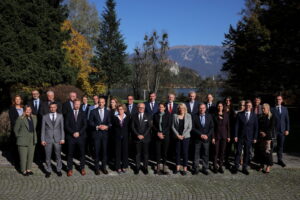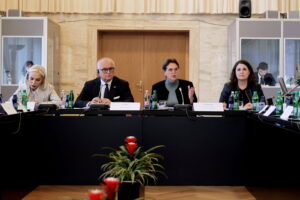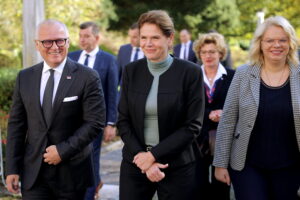Transport Ministers from the EU Strategy for Danube Region (EUSDR) Member States gathered in Bled, Slovenia, on 22 October 2024, to align a common approach on implementation of the transport policy at the level of this macro-region, which will contribute to improving connectivity and sustainable transport modes.
The EUSDR, adopted by the European Council in 2011, calls on the 14 countries of the Danube macro-region (of which 9 are EU members and 5 are candidates for EU membership) to cooperate more closely in 11 thematic areas, among which Slovenia, together with Serbia, coordinate the priority area 1b, which concerns mobility and multimodality in road, rail and air transport.
Alenka Bratušek, Minister of Infrastructure of the Republic of Slovenia, and Goran Vesić, Minister of Transport, Construction and Infrastructure of the Republic of Serbia, led a ministerial discussion on the matters of a common interest in this area. The participants discussed a number of outstanding issues related to making transport in all countries of the Danube macro-region competitive, attractive, safe and, above all, more environmentally friendly. In addition to the topic of connectivity towards a sustainable transport infrastructure and cleaner transport, they also addressed the issue of how to finance transport infrastructure, in line with the European standards set out in the EU Regulation on Union guidelines for the development of the trans-European transport network (TEN-T Regulation), which was adopted in June this year.
The main objectives of the ministerial meeting were: to deepen the established high-level cooperation, to agree on the need for a common approach to address common challenges, to promote key connectivity projects with added value for the macro-region, both for the countries of the region that are EU members and those that are currently candidates for EU membership.
At the end of the Ministerial Meeting, the representatives of the EUSDR adopted a Joint Statement expressing their equal support for the development of all forms of transport and in particular those that contribute to a cleaner environment, e.g. rail transport. They also called for the maintenance and construction of resilient transport infrastructure, the improvement of road safety and the introduction of sustainable mobility in urban centres. In addition, the Statement called for awareness of the need to dual-use the available infrastructure (for civilian and military purposes) and finally condemned the aggression against Ukraine and the destruction of transport infrastructure on its territory.




